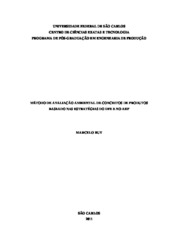Método de avaliação ambiental de conceitos de produtos baseado nas estratégias do DFE e no AHP
Resumo
The objective of the present thesis is to propose and structure a method for environmental evaluation of products concepts based on DfE Strategies and AHP. The focus is on physical products, mainly consumer durable goods and capital goods. The justification for this choice is that sustainability is a big issue today, and in particular: the urgency of approaching environmental problems; its strong relationship with product development; and the need of methods and tools for addressing environmental issues at the initial phases of product design, more specifically methods for environmental evaluation of product concepts, due to its scarcity in the literature. This objective was reached in two stages. Initially, the method was structured in phases, stages and activities arranged in an orderly manner. The method was built from DfE strategies related to the product physical dimensions and expressed by the use and consumption of material resources. DfE Strategies was condensed in evaluation criteria. These criteria was subsequently related to a products environmental typology and further grouped by degree of similarity, forming a hierarchy of environmental criteria to be used with AHP. Thus, we sought to create a method applicable to a wide range of physical products and whose aim is to guide the user, step by step, in the evaluation of the concept that better fulfills DfE criteria, taking the whole life cycle of the product into account. In the second stage, the practical utility potential of the method was assessed by means of interviews and questionnaires with product development practitioners from three companies and with one DfE consultant. As a result, it was concluded that the proposed method constitutes in a contribution to the development of environmental responsible products.
